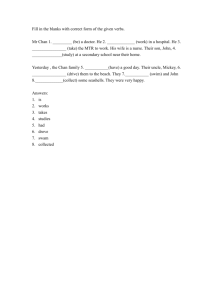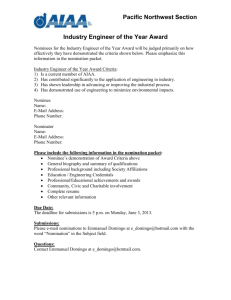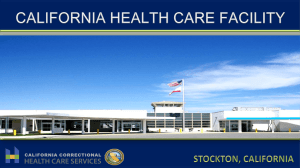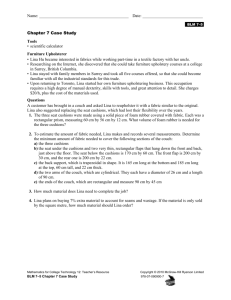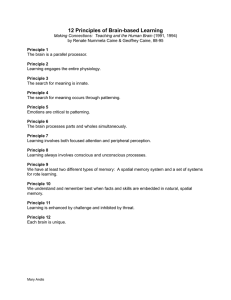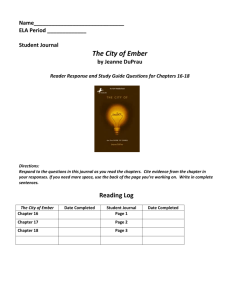Using
advertisement
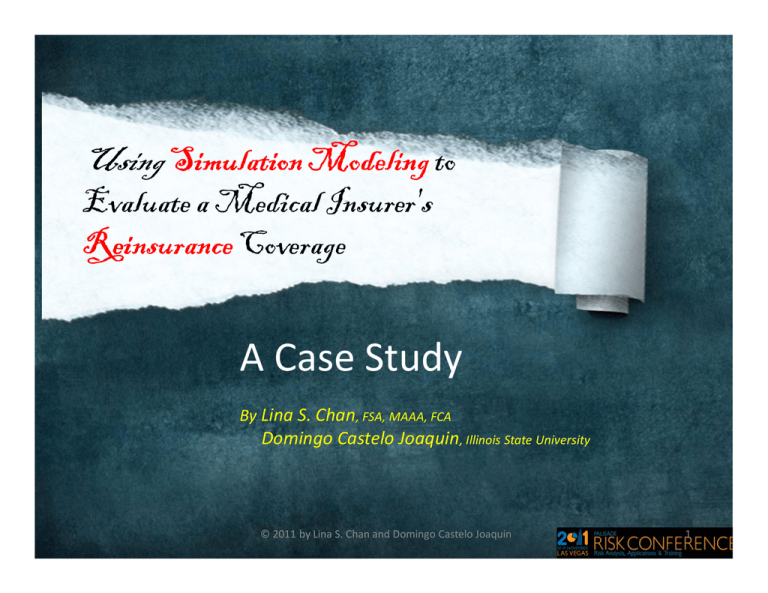
Using Simulation Modeling to Evaluate a Medical Insurer's Reinsurance Coverage A Case Study By Lina S. Chan, FSA, MAAA, FCA Domingo Castelo Joaquin, Illinois State University © 2011 by Lina S. Chan and Domingo Castelo Joaquin 1 Something about Lina S. Chan, FSA, MAAA, FCA Domingo Castelo Joaquin Using Simulation Modeling to Evaluate a Medical Insurer's Reinsurance Coverage –A Case Study © 2011 by Lina S. Chan and Domingo Castelo Joaquin 2 Lina S. Chan, FSA, MAAA, FCA, is the managing partner and founder of CP Risk Solutions, LLC. CP is a consulting firm providing actuarial, underwriting and related risk management services to insurers, reinsurers, investors, third party administrators, managing general underwriters/agents, benefit management companies, and other risk assuming companies. lina@cprisksolutions.com 3 © 2011 by Lina S. Chan and Domingo Castelo Joaquin Using Simulation Modeling to Evaluate a Medical Insurer's Reinsurance Coverage - A Case Study Lina S. Chan, FSA, MAAA, FCA Domingo Castelo Joaquin, Professor Illinois State University Domingo Castelo Joaquin is Associate Professor of Finance at Illinois State University. He specializes in decision theory, financial modeling, and real options valuation. His works have appeared in the Journal of Post Keynesian Economics, Theory & Decision, Economic Letters, Quarterly Review of Economics and Finance, Risk Management and Insurance Review, and the Journal of International Money and Finance. His work has been cited in CNNfn, the New York Times, Money Magazine, Kiplinger’s, Time.com and other publications. He received his Ph.D. in Business Administration from Michigan State University (1997). dcjoaqu@ilstu.edu © 2011 by Lina S. Chan and Domingo Castelo Joaquin 4 The Case A small insurance company evaluating request for proposal to provide stop-loss coverage • The policy covers the group up to $800,000 per individual after the group pays for the first $200,000 for each individual • Huge risk exposure relative to the insurer’s capital size. N=20,000 exposures. • The insurance company wants the business but also wants to preserve its capital ($15,000,000) so it does not get into the Insurance Department's watch list. © 2011 by Lina S. Chan and Domingo Castelo Joaquin 5 Using simulation modeling to support a medical insurer’s reinsurance decision • Output variable: Ending Capital Position • Input variables: Claims frequency and individual loss severity • Decision variables: Alternative reinsurance options for the stop-loss provider. • Sensitivity analysis: Alternative claims distributions © 2011 by Lina S. Chan and Domingo Castelo Joaquin 6 ss © 2011 by Lina S. Chan and Domingo Castelo Joaquin e 1 th a 00 1 1 n 0 00 00 00 00 00 00 00 00 ,0 ,0 ,0 ,0 ,0 ,0 ,0 1 0, 50 00 50 00 50 45 -4 -4 -3 -3 -2 00 50 1 m or 0, 00 00 1 1 -2 -1 0 0 2 40 0, 0, 00 00 1 1 00 00 0, 0, -1 0 $5 6 35 30 0, 0, 00 00 01 n 20 25 20 0, 0, ,0 th a 100 15 10 50 Le # of Indivduals Individual Claim Distribution 17,853 93 80 60 40 27 13 1 3 - 7 200,000 12.00 150,000 9.00 100,000 6.00 50,000 3.00 - Untrended Excess Claim Frequncy Per 10,000 Exposure Average Untrended Excess Claim Severity Historical Un-trended Excess Claims 2000 2001 2002 2003 2004 2005 Incidence Year Average Untrended Excess Claim Severity Untrended Excess Claim Frequency per 10,000 © 2011 by Lina S. Chan and Domingo Castelo Joaquin 8 Trended PPPM Excess Claims Year Annual Trend Cumulative Trend Factor to 2005 2000 2001 2002 2003 2004 2005 11% 12% 13% 13% 12% 1.78 1.60 1.43 1.27 1.12 1.00 © 2011 by Lina S. Chan and Domingo Castelo Joaquin 9 Simulating the Stop Loss Opportunity • Opportunity is profitable on “Average” • What is the variability around this average? • What is the probability that the capital position would improve? • What is the probability that the capital position would be depleted? © 2011 by Lina S. Chan and Domingo Castelo Joaquin 10 Base Case Ending Capital Position • • • • • • EC = Ending capital = S + NI S = Starting Capital = $15,000,000 NI = Net Income After Tax = NIBT x (1 – T%) NIBT = Net Income Before Tax = P – C - A T% = Assumed Tax Rate = 35% P = Premium Revenue = $3,240,000 = $13.50 PPPM x 12 Months x 20,000 Exposures • C = Stop loss claims = Simulated stop loss claims • A = Administrative expenses = $278,200 = $100,000 + 5.5% x P © 2011 by Lina S. Chan and Domingo Castelo Joaquin 11 Fitted Claim Frequency Distribution • Poisson distribution • • • • • • Assume loss events are independent n=20,000 exposure P=1.10% Average: np = 220.99 Variance: np(1-p) = 218.55 Average ~ Variance Incidence year Frequency Exposure Relative Frequency 2000 2001 2002 2003 2004 2005 Total/Composite 96 142 123 225 159 150 895 10,000 11,000 12,000 14,000 16,000 18,000 81,000 0.009600 0.012909 0.010250 0.016071 0.009938 0.008333 0.011049 © 2011 by Lina S. Chan and Domingo Castelo Joaquin 12 Fitted Loss Frequency and Loss Severity Distributions • Poisson distribution to model claims frequency • Generalized beta distribution to model severity of claims from known sources • Generalized beta distribution to model the distribution of 2006 trend factors. • Three best fitting distributions for trended claims (out of more than ten continuous parametric distributions with positive support. ) Model 1: Lognormal Model 2: Inverse Gauss Model 3: Log Logistic © 2011 by Lina S. Chan and Domingo Castelo Joaquin 13 Base Case Simulation Results (1) Minimum Maximum Mean Standard Deviation Variance Skewness Kurtosis Number of Errors Mode 5.0% 10.0% 15.0% 20.0% 25.0% 30.0% 35.0% 40.0% 45.0% 50.0% 55.0% 60.0% 65.0% 70.0% 75.0% 80.0% 85.0% 90.0% 95.0% Pr(End Cap > Start Cap) Pr(Lose at least 5%) (2) (3) (4) Model 1 Model 2 Model 3 13,016,180 16,308,390 15,096,990 476,066 226,638,700,000 (0.54) 3.33 15,261,760 13,239,700 16,330,050 15,200,800 411,814 169,590,500,000 (0.50) 3.42 15,359,460 10,684,770 16,197,110 14,384,980 696,552 485,184,300,000 (0.43) 3.21 14,246,240 14,236,050 14,457,140 14,607,680 14,707,870 14,803,430 14,886,180 14,956,940 15,019,420 15,083,460 15,141,330 15,196,480 15,256,880 15,316,120 15,377,970 15,436,370 15,507,210 15,581,310 15,673,920 15,794,830 61.6% 5.2% 14,468,640 14,657,730 14,777,410 14,864,240 14,949,700 15,017,570 15,072,650 15,126,920 15,181,040 15,235,360 15,284,080 15,334,450 15,385,610 15,441,650 15,491,520 15,549,600 15,616,050 15,697,850 15,821,650 71.4% 1.9% 13,160,680 13,450,260 13,663,460 13,821,670 13,953,090 14,056,990 14,163,760 14,253,170 14,348,060 14,435,680 14,526,420 14,609,330 14,691,060 14,780,080 14,880,000 14,984,700 15,093,710 15,242,110 15,450,260 19.4% 39.8% © 2011 by Lina S. Chan and Domingo Castelo Joaquin 14 Managing downside risk with Reinsurance • What is reinsurance? • Why use reinsurance? • Who uses reinsurance? • What are the reinsurance structure? © 2011 by Lina S. Chan and Domingo Castelo Joaquin 15 Reinsurance Structures • Excess of Loss – Specific and/or Aggregate © 2011 by Lina S. Chan and Domingo Castelo Joaquin 16 Reinsurance Structures • Quota Share Simple Arithmetic Example – 50% quota share, 20% ceding commission (administrative allowance) Insurer’s Retention Reinsurer’s Assumption Total $5 MM $5 MM $10 MM Ceding Commission + $1 MM - $1 MM $0 MM Claims - $4 MM - $4 MM - $8 MM $2 MM $0 MM $2 MM Premium Net Income before actual administrative expenses & tax © 2011 by Lina S. Chan and Domingo Castelo Joaquin 17 Managing downside risk with Reinsurance The Case Study - Two alternative risk management strategies: (1) a 50% quota share reinsurance (2) an aggregate excess reinsurance combined with a 50% quota share reinsurance. © 2011 by Lina S. Chan and Domingo Castelo Joaquin 18 Capital position with 50% quota share reinsurance • • • • • • • • • • • • EC = Ending capital = S + NI S = Starting Capital = $15,000,000 NI = Net Income After Tax = NIBT x (1 – T%) NIBT = Net Income Before Tax = P – C – A – (RP–RC–CC) = (P–RP) – (C-RC) – (A-CC) T% = Assumed Tax Rate = 35% P = Premium revenue = $3,240,000 C = Stop loss claims = Simulated stop loss claims A = Administrative expenses = $278,200 RP = Ceded quota share reinsurance premium revenue = 50% x P = $1,620,000 CC = Quota share reinsurance ceding commission = 10% x RP = $162,000 RC = Quota share reinsurance claim recovery = 50% x Stop loss claim. © 2011 by Lina S. Chan and Domingo Castelo Joaquin 19 Capital position with 50% quota share reinsurance © 2011 by Lina S. Chan and Domingo Castelo Joaquin 20 Capital position with 50% quota share reinsurance (1) Minimum Maximum Mean Standard Deviation Variance Skewness Kurtosis Number of Errors Mode 5.0% 10.0% 15.0% 20.0% 25.0% 30.0% 35.0% 40.0% 45.0% 50.0% 55.0% 60.0% 65.0% 70.0% 75.0% 80.0% 85.0% 90.0% 95.0% Pr(End Cap > Start Cap) Pr(Lose at least 5%) (2) Model 1 (3) Model 2 (4) Model 3 14,022,970 15,669,080 15,063,380 238,033 56,659,680,000 (0.54) 3.33 15,145,760 14,134,740 15,679,910 15,115,280 205,907 42,397,630,000 (0.50) 3.42 15,194,610 12,857,270 15,613,440 14,707,380 348,276 121,296,100,000 (0.43) 3.21 14,638,000 14,632,910 14,743,460 14,818,720 14,868,820 14,916,600 14,957,970 14,993,360 15,024,600 15,056,620 15,085,550 15,113,130 15,143,320 15,172,950 15,203,870 15,233,070 15,268,490 15,305,540 15,351,840 15,412,300 14,749,210 14,843,750 14,903,590 14,947,000 14,989,740 15,023,670 15,051,210 15,078,350 15,105,400 15,132,560 15,156,930 15,182,110 15,207,690 15,235,710 15,260,640 15,289,690 15,322,910 15,363,810 15,425,710 14,095,220 14,240,020 14,346,610 14,425,720 14,491,430 14,543,380 14,596,760 14,641,470 14,688,910 14,732,720 14,778,100 14,819,550 14,860,410 14,904,930 14,954,890 15,007,240 15,061,740 15,135,940 15,240,020 64.0% 1.1% 73.6% 0.1% © 2011 by Lina S. Chan and Domingo Castelo Joaquin 20.6% 10.4% 21 Capital position with 50% quota share reinsurance + aggregate excess • • • • • • • • • • • • • • • • • EC = Ending capital = S + NI S = Starting Capital = $15,000,000 NI = Net Income After Tax = NIBT x (1 – T%) NIBT = Net Income Before Tax = (P–C–A)–(RP–RC–CC)–(ARP–ARC) =(P – RP - ARP) - (C – CC - ARC) - (A - CC) T% = Assumed Tax Rate = 35% P = Premium revenue = $3,240,000 C = Stop loss claims = Simulated stop loss claims A = Administrative expenses = $278,200 RP = Ceded quota share reinsurance premium revenue = 50% x P = $1,620,000 CC = Quota share reinsurance ceding commission = 10% x RP = $162,000 RC = Quota share reinsurance claim recovery = 50% x Stop loss clam ARP = Aggregate excess reinsurance premium = $100,000 ARA = Aggregate excess attachment point = $1,950,000 ARM = Aggregate excess maximum coverage = $1,000,000 ARC = Aggregate excess reinsurance recovery = MIN(MAX[(C – RC) – ARA,0],ARM) © 2011 by Lina S. Chan and Domingo Castelo Joaquin 22 Capital position with 50% quota share reinsurance + aggregate excess © 2011 by Lina S. Chan and Domingo Castelo Joaquin 23 Capital position with 50% quota share reinsurance + aggregate excess (1) Minimum Maximum Mean Standard Deviation Variance Skewness Kurtosis Number of Errors Mode 5.0% 10.0% 15.0% 20.0% 25.0% 30.0% 35.0% 40.0% 45.0% 50.0% 55.0% 60.0% 65.0% 70.0% 75.0% 80.0% 85.0% 90.0% 95.0% Pr(End Cap > Start Cap) Pr(Lose at least 5%) (2) Model 1 14,607,970 15,604,080 15,009,880 213,237 45,470,180,000 (0.04) 2.23 14,644,970 14,644,970 14,678,460 14,753,720 14,803,820 14,851,600 14,892,970 14,928,360 14,959,600 14,991,620 15,020,550 15,048,130 15,078,320 15,107,950 15,138,870 15,168,070 15,203,490 15,240,540 15,286,840 15,347,300 53.5% 0% (3) Model 2 14,644,970 15,614,910 15,054,320 195,532 38,232,680,000 (0.20) 2.52 14,644,970 (4) Model 3 13,442,270 15,548,440 14,774,610 196,780 38,722,300,000 0.85 4.30 14,644,970 14,684,210 14,778,750 14,838,590 14,882,000 14,924,740 14,958,670 14,986,210 15,013,350 15,040,400 15,067,560 15,091,930 15,117,110 15,142,690 15,170,710 15,195,640 15,224,690 15,257,910 15,298,810 15,360,710 62.5% 0% © 2011 by Lina S. Chan and Domingo Castelo Joaquin 14,644,970 14,644,970 14,644,970 14,644,970 14,644,970 14,644,970 14,644,970 14,644,970 14,644,970 14,667,720 14,713,100 14,754,550 14,795,410 14,839,930 14,889,890 14,942,240 14,996,740 15,070,940 15,175,020 14.8% 0.5% 24 Sensitivity Analyses Number of claims filed with trust Claim severity/3rd known condition Claim severity/4th known condition Claim severity/unknown condition 2006 trend factor Standardized Beta / Without Reinsurance Standardized Beta / 50% Quota Share Standardized Beta / with Aggregate Excess (0.170) (0.170) (0.170) (0.087) (0.087) (0.088) (0.080) (0.080) (0.082) (0.068) to (0.082) (0.068) to (0.082) (0.065) to (0.077) (0.075) (0.075) (0.075) © 2011 by Lina S. Chan and Domingo Castelo Joaquin 25 Weakness in the contractual relationship: Medical insurer relies on the self-funded, self-administered Trust to perform accurate and unbiased administration consistent with guidelines. Risk management procedures: Clear administration and stop loss agreements with strong contractual ramifications Frequent underwriting, claim and transactional audits on the Trust’s administration Monitoring such as on-going claim experience reports, reports on individuals hitting catastrophic claim diagnosis, and reports on individuals reaching 50% of deductible Claims and medical management support such as health care provider reimbursement negotiations, contracts with tertiary care and specialty provider network networks Close working relationship with the Trust as an “involved” partner informed of underwriting and administration development © 2011 by Lina S. Chan and Domingo Castelo Joaquin 26 Critical Risk Management Issues The model results for management decision are performed. Now what? • Actual will deviate expected. • Actual could be on either side of the curve • For desirable financial outcome, involved risk partners must have AIR • Accountability • Information • Resources • AIR for this Case Study © 2011 by Lina S. Chan and Domingo Castelo Joaquin 27 Lina S. Chan, FSA, MAAA, FCA Questions? Domingo Castelo Joaquin © 2011 by Lina S. Chan and Domingo Castelo Joaquin 28
